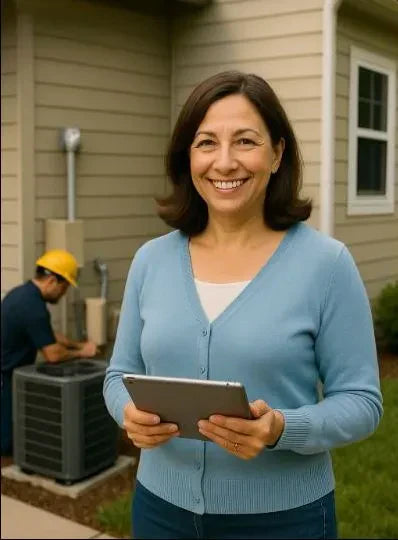Maintenance Made Simple: How to Keep a 30,000 BTU System Running Efficiently
A 30,000 BTU heating and cooling system can deliver reliable comfort, consistent airflow, and stable energy use—but only if the system is maintained regularly.
Unlike appliances you can forget about until something goes wrong, HVAC systems thrive with preventive care. Small tasks done consistently prevent expensive repairs, improve indoor air quality, and help your system reach a full lifespan—often 15–20+ years.
This guide breaks maintenance into practical steps any homeowner can follow. You won’t need specialized tools, and you don’t have to be a technician. Just a consistent routine and a clear plan.
Let’s walk through it together.
Why Maintenance Matters: The “Cause and Effect” Reality
When maintenance slips, airflow declines, efficiency drops, and components start working harder than they should. That extra strain shortens life expectancy and increases operating costs—slowly at first, then suddenly. cleanpower.org
Three things happen when maintenance is ignored:
| What Declines | How It Impacts You |
|---|---|
| Airflow | Rooms feel uneven in temperature |
| Efficiency | Energy bills rise gradually |
| Component health | Repairs become more likely |
On the flip side, consistent maintenance supports:
-
Stable temperatures
-
Lower utility bills
-
Cleaner indoor air
-
Quieter performance
-
Longer lifespan
Think of it as a partnership—your HVAC system delivers comfort, and you support it with care.
The 5 Core Pillars of HVAC Care
To make this simple, maintenance can be broken down into five key areas:
-
Filters
-
Coils
-
Airflow & Ducting
-
Condensate Management
-
System Settings & Controls
Each one plays a role in performance—and when one is neglected, the whole system feels the impact.
Let’s go step-by-step.
1. Filter Replacement: The Non-Negotiable Habit
Filters support airflow and protect internal components. When they clog, your system works harder than necessary. trane.com
Replace filters every:
-
30–60 days with standard fiberglass filters
-
60–90 days with pleated filters
-
6–12 months with high-capacity media filters
If you have:
-
Pets
-
Construction nearby
-
Allergies
-
A highly dusty environment
…check monthly.
Quick Tip: Always check airflow direction arrows before installing a filter.
This single step protects the blower motor, prevents coil icing, and supports efficiency.
2. Indoor & Outdoor Coil Cleaning: Quiet but Critical
Both the evaporator coil (inside) and condenser coil (outside) support heat transfer. When coated in dust, pollen, pet hair, or grease, efficiency declines. ehasolutions.com
Signs your coils need cleaning:
-
Sudden spike in utility bills
-
System running longer to reach temperature
-
Warmer air during cooling mode
-
Ice buildup on refrigerant lines
Coil cleaning is typically done professionally once a year, though light outdoor rinsing can help between tune-ups—as long as you avoid high-pressure sprayers.
3. Protecting Airflow: Ducts, Registers & Vents
Your HVAC system depends on unblocked airflow. Anything that restricts it increases pressure inside the system.
Monthly checklist:
-
Ensure vents remain open (closing vents doesn’t save energy—it strains the blower)
-
Remove obstructions like furniture, curtains, or rugs
-
Wipe dust buildup from registers
Every 3–5 years:
Schedule duct cleaning if you see visible build-up.
Good airflow is foundational—it’s the difference between a system that runs freely and one that struggles.
4. Managing Condensation and Drainage
Cooling systems remove humidity as part of normal operation. The water collected travels through a drain line. If that line clogs, leaks can occur, or the system may shut down to protect itself. cielowigle.com
Seasonal maintenance includes:
-
Checking the condensate line for blockages
-
Ensuring the drain pan is clean and dry
-
Using approved cleaning solutions such as vinegar (in small installments)
If your system includes a float switch, it will shut down automatically if a clog is detected—which protects the home, but can feel confusing.
Proper drainage ensures smooth operation, especially during summer.
5. System Settings, Thermostats & Controls
Smart thermostats and programmable controls help optimize energy use. But settings need periodic review—especially after:
-
Vacations
-
Power outages
-
Seasonal changes
A good rule of thumb:
-
Heating comfort range: 68–72°F
-
Cooling comfort range: 73–76°F
If your home feels uneven, check:
-
Fan mode: Auto, not On
-
Thermostat batteries (if applicable)
-
Scheduled routines
These adjustments support consistency and reduce unnecessary runtime.
Your Seasonal HVAC Maintenance Checklist
A simple HVAC maintenance checklist helps break tasks into small steps:
| Season | Task Highlights |
|---|---|
| Spring | Change air filter, clean outdoor unit, test cooling mode |
| Summer | Clear debris around condenser, monitor drain line, check thermostat |
| Fall | Replace filter, inspect gas furnace components, test heating mode |
| Winter | Keep vents clear, check airflow, monitor unusual noises |
If you’re unsure, scheduling a biannual tune-up provides peace of mind.
When to Call a Professional
DIY maintenance has limits. Bring in a licensed technician if you notice:
-
Burning smells
-
Loud grinding or rattling
-
Sudden high energy bills
-
Low airflow in multiple rooms
-
Frequent short cycling
-
Ice on refrigerant lines
A professional tune-up typically includes:
-
Refrigerant pressure testing
-
Safety checks
-
Deep coil cleaning
-
Duct pressure evaluation
-
Burner and flue inspection (for furnaces)
Think of it as an annual wellness visit for your HVAC system.
Final Thoughts: Maintenance Protects Your Investment
A 30,000 BTU system is sized for efficiency—not excess. That means maintenance plays a vital role, because smaller systems are designed to run steadily and precisely.
When you replace filters, keep coils clean, stay aware of airflow, and schedule tune-ups, the system rewards you with:
-
Cleaner indoor air
-
Longer equipment life
-
Quieter performance
-
Consistent comfort year-round
Maintenance isn’t complicated—it’s just intentional.
And once it's part of your routine, the HVAC system becomes one less thing you have to worry about.
In the next blog, you will dive deep into "Troubleshooting Common Performance Issues in Small HVAC Systems".







